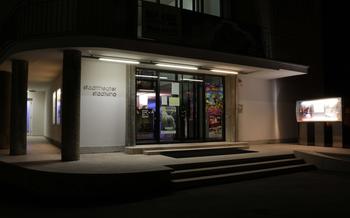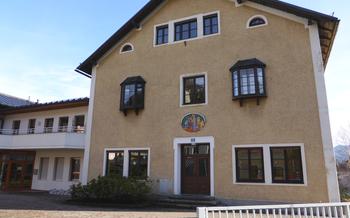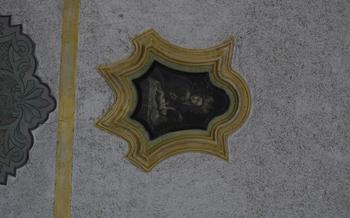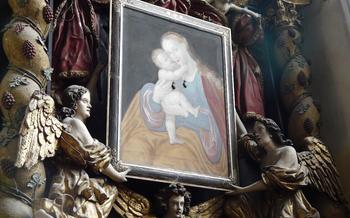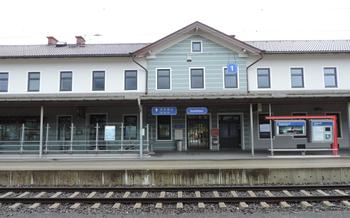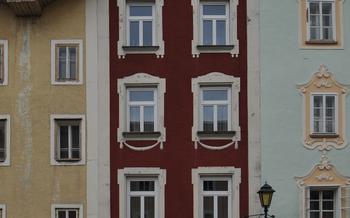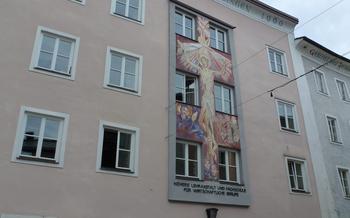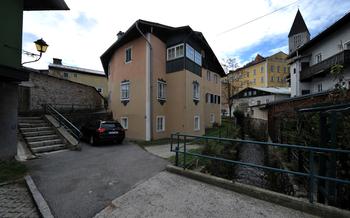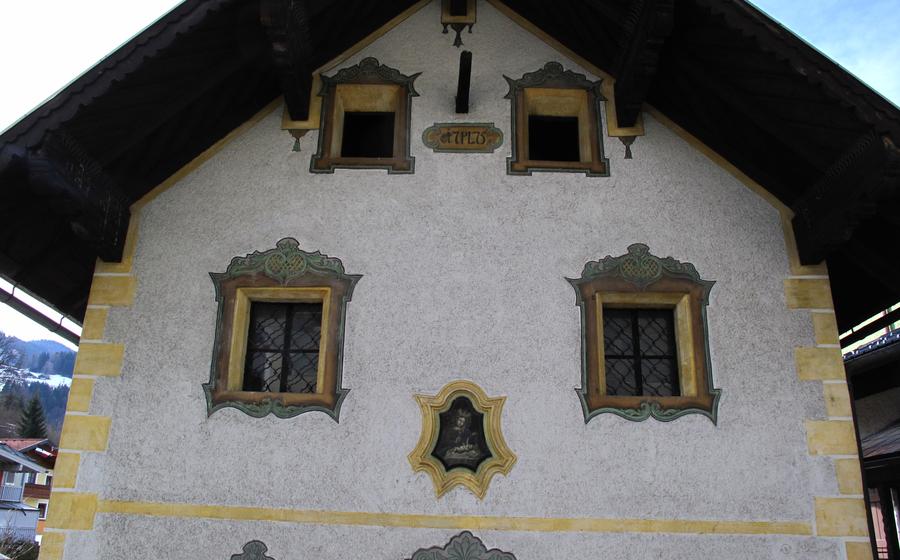
Stille Nacht Museum in Hallein (Silent Night Museum)
- Silent Night Museum: A Journey Through History
- Location and Accessibility
- Ticket Prices and Opening Hours
- Silent Night Chapel: A Place of Reflection and Celebration
- Exhibits and Displays: Unveiling the Story
- Interactive Experiences: Engaging with the Past
- Museum Shop: A Treasure Trove of Mementos
- Engaging the Young Explorers: Family-Friendly Activities at the Silent Night Museum
- Children's Workshops: Creativity and Storytelling
- Interactive Exhibits for Kids: Hands-on Learning
- Family-Friendly Tours: Exploring Together
- Audio Guides and Translations: Enhancing the Experience
- Historical Context: Setting the Stage
- The Gruber Family: Behind the Carol
- Nearby Attractions: Exploring the Region
- Insider Tip: Making the Most of Your Visit
Silent Night Museum: A Journey Through History
The Silent Night Museum in Hallein, Austria, is a captivating destination that takes visitors on a journey through the history of the beloved Christmas carol, "Silent Night." This iconic carol, known worldwide as "Stille Nacht," holds a special place in the hearts of millions and has become an integral part of Christmas celebrations around the globe.
The museum's mission is to preserve and celebrate the legacy of "Silent Night" and its creators, Franz Xaver Gruber and Joseph Mohr. Through a variety of interactive exhibits, visitors can delve into the historical context surrounding the carol's creation and its subsequent rise to global fame. The museum's dedication to showcasing the enduring impact of this timeless melody makes it a must-visit destination for music enthusiasts, history buffs, and anyone seeking a deeper understanding of this cherished Christmas tradition.
Among the museum's highlights are interactive displays that bring the story of "Silent Night" to life. Visitors can explore the lives of Gruber and Mohr, learn about the circumstances that inspired the creation of the carol, and witness the global impact it has had over the years. These engaging exhibits offer a unique and memorable experience that allows visitors to connect with the history and significance of this beloved song.
Location and Accessibility
The Stille Nacht Museum is conveniently located in the heart of Hallein, Austria, at Stille-Nacht-Platz Visitors can easily reach the museum by public transportation, using either the S-Bahn or bus lines 170 and 180. The Hallein train station is a short walk from the museum, making it accessible by train as well. For those traveling by car, there are several parking options available in the vicinity of the museum.
Ticket Prices and Opening Hours
Visiting the Stille Nacht Museum is a budget-friendly experience. Admission fees for adults are set at 7 euros, while children between the ages of 6 and 15 can enter for 4 euros. Families with two adults and two children can purchase a family ticket for 18 euros. The museum also offers discounted rates for groups of 10 or more, with prices starting at 5 euros per person.
Silent Night Chapel: A Place of Reflection and Celebration
The Silent Night Chapel, a centerpiece of the Stille Nacht Museum, holds immense significance within the museum's narrative. Designed by renowned Austrian architect Josef Thorak, the chapel serves as a sanctuary dedicated to the iconic carol and its enduring legacy. Its unique architectural features, including a striking timber roof resembling an organ, create a warm and inviting ambiance, fostering a sense of serenity and contemplation. The chapel's acoustics are meticulously engineered to enhance the melodious strains of the Silent Night carol, offering visitors a truly immersive experience. Throughout the year, the chapel hosts concerts, recitals, and special events, including poignant performances of the Silent Night carol, further enriching the museum's offerings and immersing visitors in the rich history and cultural significance of this beloved song.
Exhibits and Displays: Unveiling the Story
The Stille Nacht Museum in Hallein boasts a diverse collection of exhibits and displays that bring the story of the Silent Night carol to life. Permanent exhibitions showcase the history of the carol, from its humble beginnings to its global impact. Visitors can learn about the lives of Franz Xaver Gruber, the composer of the melody, and Joseph Mohr, who wrote the lyrics. Original manuscripts, historical documents, and artifacts related to the carol's creation are on display, providing a fascinating glimpse into the past.
In addition to the permanent exhibits, the museum also features temporary exhibitions and rotating displays that explore various aspects of the Silent Night story. These exhibitions may focus on specific themes, such as the carol's influence on popular culture or its impact on different countries around the world. The museum's curators work diligently to present fresh and engaging content that keeps visitors coming back for more.
Guided tours of the museum are available for those who wish to delve deeper into the exhibits and learn more about the history of the Silent Night carol. Knowledgeable guides provide insights into the creation of the carol, the lives of its creators, and the enduring legacy of this beloved Christmas song.
Interactive Experiences: Engaging with the Past
The Silent Night Museum offers a variety of interactive experiences that allow visitors to engage with the exhibits and immerse themselves in the story of Silent Night. Interactive displays, multimedia presentations, and hands-on activities bring the past to life and make the museum experience more engaging and memorable.
Visitors can interact with touchscreens to learn more about the history of the carol, listen to audio recordings of the song in different languages, and even try their hand at conducting a virtual choir. Multimedia presentations transport visitors back in time to experience the historical events surrounding the creation of Silent Night.
For a hands-on experience, visitors can participate in workshops where they can learn to make their own Silent Night ornaments, sing along with the carol, or even create their own musical compositions inspired by the song. These interactive activities are a great way for visitors of all ages to engage with the museum's exhibits and gain a deeper understanding of the Silent Night story.
Museum Shop: A Treasure Trove of Mementos
The Stille Nacht Museum's gift shop is a treasure trove of unique souvenirs and memorabilia that allow visitors to take a piece of the Silent Night story home with them. From traditional Austrian handicrafts to Silent Night-themed items, the shop offers a wide range of products for visitors of all ages.
One of the highlights of the shop is the Silent Night-themed items, which include collector's editions of the carol in various languages, decorative ornaments, and unique gifts inspired by the song's history and message. These items make for cherished keepsakes or thoughtful presents for friends and family.
By purchasing souvenirs from the museum shop, visitors not only take home a tangible reminder of their visit but also support the museum's mission to preserve and promote the legacy of Silent Night. The revenue generated from the shop helps fund the museum's ongoing exhibitions, educational programs, and research initiatives, ensuring that the story of this beloved carol continues to be shared with generations to come.
Engaging the Young Explorers: Family-Friendly Activities at the Silent Night Museum
The Silent Night Museum offers a range of activities and exhibits that cater to younger visitors, ensuring a memorable and engaging experience for families. Children's workshops, interactive exhibits, and family-friendly tours are designed to spark curiosity and provide hands-on learning opportunities.
Children's Workshops: Creativity and Storytelling
The museum organizes themed workshops for children, where they can unleash their creativity and explore the story of Silent Night through art, music, and storytelling. These workshops provide a fun and educational environment for kids to learn about the history and legacy of the carol.
Interactive Exhibits for Kids: Hands-on Learning
Interactive exhibits throughout the museum are designed to engage younger visitors and make learning fun. Children can play musical instruments, dress up in traditional clothing, and participate in interactive games that bring the Silent Night story to life.
Family-Friendly Tours: Exploring Together
Families can embark on guided tours tailored to their needs, ensuring a comprehensive and enjoyable experience for all age groups. These tours provide insights into the history of the carol, the Gruber family, and the cultural significance of Silent Night.
By offering these family-friendly activities, the Silent Night Museum creates a welcoming space for children to learn, explore, and connect with the history and legacy of this beloved Christmas carol.
Audio Guides and Translations: Enhancing the Experience
The Stille Nacht Museum recognizes the importance of making its exhibits accessible to visitors from diverse linguistic backgrounds. To enhance the understanding and enjoyment of visitors, the museum offers audio guides in several languages. These guides provide insightful commentary and explanations of the exhibits, allowing non-native speakers to fully immerse themselves in the museum's narrative. By listening to the audio guides, visitors can gain a deeper appreciation of the historical context and cultural significance of the Silent Night carol.
In addition to audio guides, the museum also provides translations of its exhibits and signage in multiple languages. This ensures that visitors from all over the world can navigate the museum with ease and understand the information presented. By offering these language options, the Stille Nacht Museum demonstrates its commitment to inclusivity and ensures that all visitors have a rich and rewarding experience, regardless of their linguistic background.
Historical Context: Setting the Stage
The creation of the Silent Night carol was influenced by a confluence of historical events, social and cultural factors, and regional significance. Let's delve deeper into the historical context of this beloved carol:
Historical Events:
The Silent Night carol emerged during a turbulent period in European history. The Napoleonic Wars had just ended, and the Holy Roman Empire had dissolved, leading to significant political and social changes. This period of upheaval and transformation provided the backdrop for the carol's creation.
Social and Cultural Background:
The early 19th century was a time of great social and cultural change in Europe. The Industrial Revolution was gaining momentum, leading to shifts in societal structures and values. Amidst this transformation, people sought solace and comfort in religious and spiritual traditions, contributing to the popularity of carols like Silent Night.
Regional Significance:
The Silent Night carol holds particular significance in the Salzburg region, where it was composed. The region's rich musical heritage and strong Catholic traditions provided a fertile ground for the carol's creation and dissemination. The carol quickly became an integral part of the region's Christmas celebrations, spreading its message of peace and hope throughout the world.
The Gruber Family: Behind the Carol
The creation of Silent Night is deeply intertwined with the Gruber family, whose musical talents played a crucial role in the carol's composition. Franz Xaver Gruber, born in 1787, was a gifted organist and teacher who resided in the small town of Oberndorf bei Salzburg. His passion for music and his skill as a composer led him to create the melody for Silent Night, which would later become one of the most beloved Christmas carols in the world.
Joseph Mohr, a young priest who arrived in Oberndorf in 1816, wrote the lyrics for Silent Night, inspired by the peaceful and serene atmosphere of the Christmas season. Mohr's poetic words perfectly captured the spirit of the carol, expressing a message of hope, love, and peace that would resonate with generations to come.
The Gruber family's musical legacy extends beyond Franz Xaver Gruber. His brother, Johann Evangelist Gruber, was also a talented organist, and his son, Franz Xaver Gruber Jr., followed in his father's footsteps as a musician and composer. The Gruber family's dedication to music and their contribution to the creation of Silent Night have left an indelible mark on the history of Christmas carols.
Nearby Attractions: Exploring the Region
While delving into the history of Silent Night at the Stille Nacht Museum, visitors can also explore the captivating attractions that surround the area. A short walk from the museum lies the Hallein Salt Mine, a fascinating underground labyrinth that invites visitors to discover the secrets of salt mining. Embark on a guided tour to witness the ancient mining techniques and marvel at the subterranean wonders that lie beneath the surface.
For those interested in delving deeper into the region's rich history, the Celtic Museum in Hallein offers a glimpse into the lives of the ancient Celts who once inhabited these lands. Explore their fascinating culture, traditions, and artistic expressions through interactive exhibits and engaging displays.
To experience the breathtaking beauty of the surrounding Alps, take a ride on the Untersberg Cable Car. Ascend to dizzying heights and soak in the panoramic vistas of the majestic mountains, lush forests, and sparkling lakes that paint a picture of tranquility and wonder.
Insider Tip: Making the Most of Your Visit
To truly immerse yourself in the history and significance of the Silent Night carol, consider booking a guided tour of the museum. An experienced guide can provide insights and anecdotes that will enhance your understanding of the exhibits.
For a truly unforgettable experience, plan your visit to coincide with one of the Silent Night performances or concerts held at the museum. These special events offer a chance to hear the carol performed live in the historic chapel, creating a truly magical atmosphere.
While in the region, take the opportunity to sample the delicious local cuisine. Hallein and its surroundings offer a variety of restaurants serving traditional Austrian dishes, allowing you to experience the region's culinary delights firsthand.
